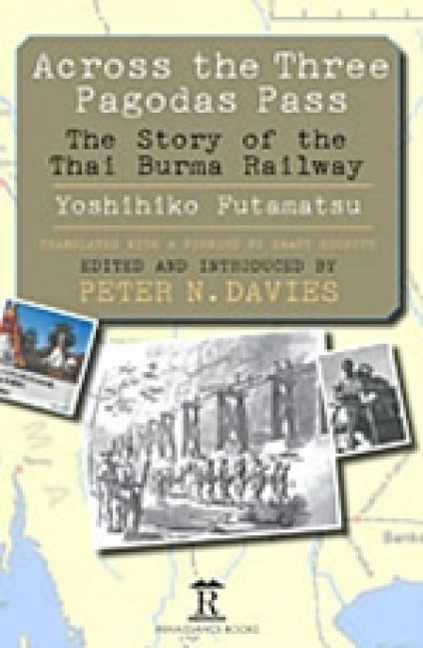Book contents
- Frontmatter
- Dedication
- Contents
- Acknowledgements
- Foreword
- Introduction
- Across the Three Pagodas Pass
- Translator’s Acknowledgements
- Preface
- Chapter 1 Departure for the Front
- Chapter 2 In Indo-China
- Chapter 3 Opening of Hostilities
- Chapter 4 The River Krian
- Chapter 5 The Malayan Campaign
- Chapter 6 The Fall of Singapore
- Chapter 7 Surrender
- Chapter 8 Shōnan: Light of the South
- Chapter 9 The Thai-Burma Railway
- Chapter 10 Preparing Construction
- Chapter 11 Banpong
- Chapter 12 Prisoners-of-War
- Chapter 13 Constructing the Railway
- Chapter 14 Thailand
- Chapter 15 The River Kwae Noi
- Chapter 16 The Mae Khlaung Bridge
- Chapter 17 Kanchanaburi
- Chapter 18 The Jungle
- Chapter 19 From Bangkok to Singapore
- Chapter 20 Rush Construction
- Chapter 21 The Base at Wanyai
- Chapter 22 The Labour Force
- Chapter 23 Survey Unit
- Chapter 24 Test Run
- Chapter 25 Bridge-Building and Shifting Earth
- Chapter 26 The Rainy Season: The Monsoon
- Chapter 27 Kinsaiyok
- Chapter 28 Diseases and Epidemics
- Chapter 29 Cattle Drive
- Chapter 30 Living in the Jungle
- Chapter 31 Soon to the Three Pagodas Pass
- Chapter 32 Towards the Setting Sun
- Chapter 33 Opening to Traffic
- Chapter 34 The Bombing
- Chapter 35 End of the War
- Chapter 36 Internment
- Chapter 37 Repatriation
- Footnote
- Postscript
- End Notes
- Glossary
- Bibliography
- Index
Chapter 25 - Bridge-Building and Shifting Earth
Published online by Cambridge University Press: 13 May 2022
- Frontmatter
- Dedication
- Contents
- Acknowledgements
- Foreword
- Introduction
- Across the Three Pagodas Pass
- Translator’s Acknowledgements
- Preface
- Chapter 1 Departure for the Front
- Chapter 2 In Indo-China
- Chapter 3 Opening of Hostilities
- Chapter 4 The River Krian
- Chapter 5 The Malayan Campaign
- Chapter 6 The Fall of Singapore
- Chapter 7 Surrender
- Chapter 8 Shōnan: Light of the South
- Chapter 9 The Thai-Burma Railway
- Chapter 10 Preparing Construction
- Chapter 11 Banpong
- Chapter 12 Prisoners-of-War
- Chapter 13 Constructing the Railway
- Chapter 14 Thailand
- Chapter 15 The River Kwae Noi
- Chapter 16 The Mae Khlaung Bridge
- Chapter 17 Kanchanaburi
- Chapter 18 The Jungle
- Chapter 19 From Bangkok to Singapore
- Chapter 20 Rush Construction
- Chapter 21 The Base at Wanyai
- Chapter 22 The Labour Force
- Chapter 23 Survey Unit
- Chapter 24 Test Run
- Chapter 25 Bridge-Building and Shifting Earth
- Chapter 26 The Rainy Season: The Monsoon
- Chapter 27 Kinsaiyok
- Chapter 28 Diseases and Epidemics
- Chapter 29 Cattle Drive
- Chapter 30 Living in the Jungle
- Chapter 31 Soon to the Three Pagodas Pass
- Chapter 32 Towards the Setting Sun
- Chapter 33 Opening to Traffic
- Chapter 34 The Bombing
- Chapter 35 End of the War
- Chapter 36 Internment
- Chapter 37 Repatriation
- Footnote
- Postscript
- End Notes
- Glossary
- Bibliography
- Index
Summary
Building a roadbed meant both building bridges and shifting earth. A roadbed to carry a railtrack had to be designed with gradients and line-curvatures, but when one looked at it on the ground it became essentially a matter of high ground being cut through and levelled offand of low places being plugged up to bring them to ground level. This is how the roadbed was formed. Mountain streams had to be crossed by building bridges and this meant unavoidable extra labour.
The total length of the railway was 415 km and there were over 300 bridges, apart from the culverts, but few of them were over 100 metres across. On Thai-side there were the Mae Khlaung steel bridge and the double plank viaduct at Arrow Hill at 103 km; on Burmaside there were the three steel bridges with their wooden by-passes over the Zami, Apalon and Mezali rivers. For small spans of 10 metres and larger spans of 70 to 90 metres the railway engineers used standard ‘text book’ bridge-building methods. Bridges occurred about one in every kilometre. For girders on the wooden bridges they used 30-cm squared timbers, one per rail. On top of the foundations made by piledriving the bridge-abutments and bridge-piers, the framework was made in the form of gate-styled columns one against another. It being entirely a temporary method, clamps were used to bolt up the timbers. It was enough to carry the weight of a train on the bridge but not enough for oscillations on impact. Location and extent were decided, and when the height of the bridge-piers was fixed it became a viable job because the construction was simple. This type of construction was not for permanence so the weak places needed strengthening against flood-times and heavy rains, the safety-factor of the foundations being low. After the railway was opened to traffic the enemy's bombing interrupted movement of traffic, the bridges being the constant target, and the construction being simple they collapsed, but again because of their simple construction they could be repaired.
The area included many jungle mountain streams which had to be bridged, and so a lorry thoroughfare was really necessary.
- Type
- Chapter
- Information
- Across the Three Pagodas PassThe Story of the Thai-Burma Railway, pp. 119 - 121Publisher: Amsterdam University PressPrint publication year: 2013



